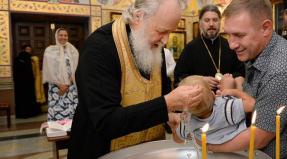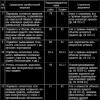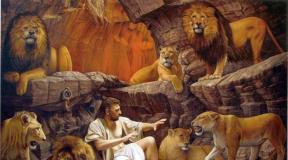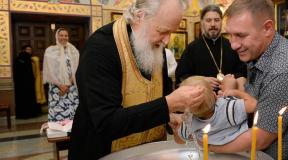Church of the Archangel Gabriel. Touch history
The church was originally built in 1707 by order of Alexander Menshikov by Ivan Zarudny with the help of Domenico Trezzini, a group of Italian and Swiss craftsmen from the cantons of Ticino and Friborg and Russian stonemasons from and.
The earliest surviving Peter the Great baroque building in Moscow, the Menshikov Tower was significantly altered in the 1770s. The church functioned only in the summer; in winter, services were held nearby, in the Church of Theodore Stratelates, built in 1782-1806. The Church of St. Theodore Stratelates also had bells for ritual melodies: despite its height, the Menshikov Tower did not have bells.
Story
The first church in the name of the Archangel Gabriel on this site was first mentioned in the 1551 census records. By 1657 it was rebuilt in stone, and was enlarged in 1679. Twenty years later, the influential statesman Alexander Menshikov consolidated land plots south of the modern one. The Church of the Archangel Gabriel became the home church of his family, who lived in the next block to the west, on the site of the current Central Post Office.
In 1701, Menshikov repaired the old church, and in 1704 he ordered its demolition. Menshikov entrusted the general management of construction to Ivan Zarudny. Domenico Trezzini, Zarudny’s subordinate, was from European masters (from families Fontana, Rusco, Ferrara etc. from the canton of Ticino), but six months later he was sent to. The new church was structurally completed by 1707, its height being 81 meters and comparable to that of . The building originally had five levels with stone (nave, square tower and three lower octagonal levels; the upper two octagons were built of wood). In 1708 the tower acquired 50 bells and an English clock mechanism. It was crowned with a 30-meter spire with an angel in the shape of a weather vane. The original building of the Menshikov Tower in Moscow was richly decorated with decorative sculpture, but most of it was lost in the 18th century.
In 1710, Menshikov was appointed governor of St. Petersburg and abandoned all his Moscow projects, taking most of the craftsmen with him. Work on the tower's interiors slowed; Menshikov's private property inside the temple was rebuilt into an ordinary altar.
In 1723, the tower was struck by lightning and the fire completely destroyed the upper wooden part with the clock. The bells fell, shattering the wooden ceilings and (partially) destroying the interiors of the naves. The side altars, however, survived and continued to function while the main tower stood decapitated until 1773. In 1773-1779 the tower was restored and acquired its current form: instead of recreating the destroyed upper octagon, the new architects replaced it with a compact but complex Baroque dome. Vases at the corners of the first octagon, installed in the 1770s, replaced the lost statues of 1723; Later, the vases were regularly replaced; the current ones are made of concrete. The windows of the octagonal vaults were filled with brick, making the installation of bells impossible. On the other hand, the originals of the sculptural decoration of this period were practically lost (modern sculpture consists mainly of cement copies).
The Menshikov Tower does not have a reliable heat supply and is closed during the winter. Instead of heating, the smaller neoclassical church of St. Theodore was built (completed 1806), which is also used as a bell tower.
In 1821-1850 the tower was the house church for the Central Post Office. The postal workers planned to open the upper level windows and install bells, but these plans did not materialize. The church was renovated from the outside, with an important addition being the pineapple-shaped spire, which has survived to this day.
The temple was looted in 1922 and lost its iconostasis; the existing iconostasis was moved from the church to, which was destroyed in the 1960s.
Literature
- Architectural monuments of Moscow. White City. Moscow: Art, 1989. p.245-251
The first mention of a wooden church in honor of the Archangel Gabriel in Moscow (now the Menshikov Tower) date back to 1551. It was rebuilt in stone by 1657, and 22 years later (in 1679) it was noticeably expanded.
At the end of the seventeenth century, an associate of Tsar Peter I, Alexander Menshikov, acquired an estate in this area, located on Myasnitskaya Street on the site of the current Main Post Office.
The close location of the Temple of the Archangel Gabriel to the courtyard of an eminent neighbor contributed to the fact that Alexander Menshikov became a parishioner of this church.
In 1701, he allocated money to repair the religious building, but already in 1704 he gave the order for its complete demolition.
Photo 1. Menshikov Tower in an old photograph
Temple of the Archangel Gabriel in Moscow - new building
The construction of the new Temple of the Archangel Gabriel (Menshikov Tower) was entrusted to Ivan Zarudny and his subordinate, the European master Domenico Trezzini. True, the latter was sent to St. Petersburg six months later.
In 1706, Alexander Menshikov donated the icon of the Polotsk Mother of God to the temple. The prince brought the Icon from near Kalishcha, from the site of his victorious battle. According to legend, this Image of the Mother of God belonged to the brush of the famous evangelist Luke.

Photo 2. Spire of the Temple of the Archangel Gabriel in Moscow
The icon survived the great fire of 1723 and the move to St. Petersburg in 1726 to Menshikov’s new home church on Vasilievsky Island, but disappeared without a trace in 1727 after the prince’s resignation.
By 1707, the Temple (Menshikov Tower) was structurally completed. The height of the building with its spire was 81 meters, which exceeded the height of the Ivan the Great Bell Tower in the Kremlin by three meters. This caused discontent among native Muscovites, who did not particularly like Alexander Danilovich.
In 1708, a clock mechanism and 50 bells were purchased for the tower (the chimes struck every quarter of an hour, half an hour and an hour, and at noon a melody sounded from all the bells). The spire was crowned with a weather vane in the form of an angel, and the walls of the temple were decorated with skillfully made decorative stucco, which was lost during the 18th century.

Photo 3. Rich decoration of the Church of the Archangel Gabriel
After Menshikov left for St. Petersburg, funding for the Temple (Menshikov Tower) ceased. It began to quickly deteriorate. Ivan Zarudny warned the prince about the possible consequences of the devastation, but Alexander Danilovich had already lost interest in his brainchild.
In 1723, a great fire occurred in the Temple of the Archangel Gabriel.
On June 14, the day of the funeral service for the priest who died the day before during evening prayer within the walls of the Temple, a thunderstorm came and lightning struck directly on the cross. The dome of the structure caught fire first. Then the fire engulfed the wooden truss, causing the domes attached there to begin to crumble and break the church vaults. Many people who tried to remove various valuables from the building engulfed in fire died in this disaster.
No money was allocated for restoration and the Temple (Menshikov Tower) stood in a destroyed state until 1773.

Photo 4. Stucco molding at the entrance to the religious building
It was this year that the restoration of the religious building was undertaken by Gabriel Izmailov, who was a member of the Masonic lodge of the Pedagogical Seminary, the so-called. Martinists.
Based on this, the temple acquired special features and its current appearance: the dome was designed in the form of a helical candle, the upper octagon was replaced with a baroque dome, the sculptures at the corners of the lower octagon were replaced with vases.
In addition, the external and internal walls of the Temple were decorated with Masonic inscriptions, symbols and emblems, which were dismantled only in 1852 on the instructions of Metropolitan Philaret.

Photo 5. Memorial plaque on the Menshikov Tower.
In 1792, a post office was located in the building of the estate of Alexander Menshikov, to which the Menshikov Tower was also assigned. Until the end of the nineteenth century, the church was considered departmental and was called the Temple of the Archangel Gabriel at the Post Office. Only due to the lack of money from the postal department to maintain the church, it became a parish.
The temple was closed for worship in the 30s of the twentieth century, during the Soviet regime.
In 1945, at the Local Council of the Russian Orthodox Church, it was decided to restore the Antioch metochion. This was connected with the arrival of Alexander III, His Majesty the Patriarch of Antioch, at the Council. The opening of the courtyard at the Temple of the Archangel Gabriel took place on July 17, 1948.
The shrines of the temple are considered to be the icons of Our Lady of the Blessed Heaven and the Archangel Gabriel, framed in a silver robe.
The Menshikov Tower (Temple of the Archangel Gabriel) is located at the address: Moscow, Arkhangelsky Lane, 15A (metro station “Chistye Prudy”).
Menshikov Tower, Church of the Archangel Gabriel on Chistye Prudy - the earliest surviving Peter the Great baroque building in Moscow. The author of the project is called Ivan Zarudny and the participation of Domenico Trezzini is expected.
The circumstances under which the Menshikov Tower was built are interesting. In these places there passes Myasnitskaya Street, which at the end of the 16th century was cut by the fortress wall of the White City, and at the intersection there were Myasnitsky Gates. The name of the street and the fortress gate comes from the butchers' settlement located outside the city walls.

And inside the city, next to the gate, in 1699 he bought the estate of A.D. Menshikov, friend and ally of Peter I. This was even before the founding of the city of St. Petersburg, so Menshikov intended to settle in the Moscow estate for a long time.

The butchers also had no intention of moving anywhere and continued to do their job, and dumped production waste into ponds located nearby. These ponds emitted a bad smell, which is why Muscovites received the dissonant name “Filthy” ponds. The fortress wall could protect the city from the enemy, but it was not able to protect against bad odors. So the aromas reached Alexander Danilovich’s nose and, presumably, greatly annoyed him.

The question is, why did he buy the estate here then? With his capabilities, it was possible to acquire ownership in a more suitable location. The case probably was in Myasnitskaya, along which one of the roads to the German settlement passed. Having bought the estate, Menshikov ordered the ponds to be cleaned, which have since been called “Chistye”. The current pond is artificial, dug after the fire of 1812. All the old ponds apparently were filled in at the same time.

Construction of the Menshikov Tower began in 1704 and ended three years later. As a result, a tower rose over the city, one and a half fathoms (3.2 meters) higher than the bell tower of Ivan the Great, which was considered the pride and one of the landmarks of Moscow. The townspeople, who disliked the prince, believed that by this Menshikov tried to “hurt” them.

In Moscow, there was a strict ban on the construction of bell towers exceeding the height of Ivan the Great. There is a version that Menshikov did not start the construction of the tower of his own free will. He would not have been allowed to exceed the height of Ivan the Great for the sake of his ambition. It is clear that Peter the Great himself ordered the construction. And the fact that construction was entrusted to a second person in the state indicates the importance of the facility.

In Moscow, Peter was worried about the fate of the German Settlement, which the archers had recently wanted to cut out. Lefort's palace (actually a fortress) was hastily built there. Before Lefort's death in 1699, there was even a Lefortovo regiment. What was needed was a reliable connection between Sloboda and the Kremlin and not only messengers. Most likely, the Menshikov Tower was built to receive alarm signals from the German Settlement and transmit them to the Kremlin, and possibly also to the regiment of Lavrentiy Sukharev, loyal to Peter, located at the newly built Sukharev Tower. In Moscow they said that through the Menshikov Tower the Kremlin was communicating with Kukuy (German Settlement).

The fact that the tower was used in the state signaling system can be judged by the following facts. Almost immediately after construction was completed, the tower was built on. It seems that shortcomings in the visual connection between the Sukharev Tower and the Kremlin have been revealed. On the top floor of the Sukharev Tower there was an observatory; it was equipped with instruments and devices for receiving visual signals. The observatory was headed by Yakov Bruce, a person who was not only versed in the exact sciences, but also enjoyed the enormous trust of the tsar.

If the Moscow Kremlin received signals from the outside, then it was most convenient to do this from the bell tower of Ivan the Great. This assumption explains why it was forbidden to build tall structures in Moscow (so as not to obscure the view) and why the Menshikov Tower was built in violation of this prohibition (to establish a visual connection with both the Kremlin and the German Settlement).

The location of the Menshikov Tower near the current Moscow Post Office also leads to interesting guesses. Visual and audio signals could convey only the briefest information such as “Danger!” But the details had to be duplicated with the help of messengers. From here it is clear: somewhere near the Menshikov Tower there must have been houses and courtyards of the messengers. That is why already in the 19th century the first Moscow post office appeared in the same quarter.

And in 1723 the tower suffered a terrible fate. An inexplicable event occurred. On June 13, one of the priests of the church fell dead on the porch after an evening service. The next day, during the funeral service, clouds gathered over the church, thunder roared, and lightning struck the cross, setting the dome on fire.

When the fire spread to the oak farmhouse, the bells began to break off and the church vaults to break through. Falling bells and fire killed people who were carrying out valuables and relics at that time. The top of the tower was completely lost. Thus, according to Muscovites, providence itself punished Menshikov for his pride.

The building stood in this form for more than fifty years. In 1787, Gavriil Izmailov, who belonged to the then existing in Moscow lodge of Masons who called themselves Martinists, undertook to restore the church. In Krivokolenny Lane, not far from the Church of the Archangel Gabriel, about fifty students of the Pedagogical Seminary, organized by the Masons, lived in the house of Professor Schwartz. It was for them that Izmailov restored the Church of the Archangel Gabriel, decorating it inside and out with Masonic symbols and emblems with Latin inscriptions.

For a long time, the authorities looked condescendingly at the existence of Masonic lodges in the country. Catherine II believed that this was just a harmless passion for mystical teachings. Everything changed when the Moscow Masons were caught in a secret connection with the Prussian court, hostile to Russia. From the decrypted secret correspondence it was clear that the “champions of enlightenment” were preparing a coup d’etat. As a result, several high-ranking masons were arrested and imprisoned in the Shlisselburg fortress.

However, the secret signs that decorated the walls of the Menshikov Tower existed for several more decades. In 1852, Metropolitan Philaret suddenly remembered the Masonic signs and Latin inscriptions and ordered them all to be destroyed. The numerous sculptural decorations that have come down to us are not just modeling or carving, they are “story sculptures” on evangelical themes, perhaps the first in the Moscow tradition.

Finally, for lovers of mysticism, a few facts. If we look at the map of Moscow as it developed after Peter the Great, when the square of Petrovskaya Yauza was added to the round Kremlin Moscow, and an irregular diamond-shaped figure with its displaced center was formed. Where is this center?

If we put a line between its most distant outposts, Luzhnetskaya and Preobrazhenskaya, the center of Moscow will be the area at the Myasnitsky Gate with the Menshikov Tower. It seems that Peter and Menshikov intuitively found a new city center.

Moreover, the Menshikov Tower was located near the top of Sretensky Hill, the highest hill in Moscow, higher than the Kremlin Hill. Here, near the post office, was then the “zero kilometer”, the beginning of all Russian roads.

And at the beginning of World War II, military control was carried out not from the Kremlin, but from the dungeons of the Kirovskaya metro station, now Chistye Prudy.

Well, in the time of Peter I, the three tallest buildings in Moscow were the Ivan the Great, Sukharev and Menshikov towers, about which Muscovites said: “The Sukharev Tower is the bride of Ivan the Great, and Menshikova is his sister.”

Epiphany Deanery
Story
The first mention of the wooden church of the Archangel Gabriel at this place dates back to the 1551 census. In 1657-1679. the building was built in stone. In 1704-1707 by order of A.D. Menshikov's temple is being rebuilt in the style of Peter the Great's Baroque. The author of the project is considered to be the architect I.P. Zarudny with the participation of D. Trezzini, G. Pando, B. Scala and sculptors D. and J. Fontana, G. Quadro, D. Rusco, C. Ferrara, P. Gemmi. The temple became the tallest building in Moscow and received the name “Menshikov Tower”. After the fire of 1723, the tower was partially restored only in 1779. It opened as a functioning church only in 1863. At the same time, the church acquired its modern appearance. In 1923, the Church of the Archangel Gabriel was closed.
The Church of the Great Martyr Theodore Stratelates was built in 1782-1806. architect I.V. Egotov in the courtyard of the Church of the Archangel Gabriel is like a warm temple with a bell tower. In 1860-1869 a northern chapel was added in honor of the icon of the Mother of God “Unexpected Joy”. Closed 1930
At the beginning of 1948, with the blessing of two churches, the Archangel Gabriel and the Great Martyr Theodore Stratilates, a metochion was located. The opening of the courtyard took place on July 17, 1948.
Shrines
Icon of the Archangel Gabriel in a silver robe in the local row of the iconostasis; Icon of the Mother of God “Blessed Heaven” to the left of the Royal Doors (Church of the Archangel Gabriel).
Icon of the Mother of God “Unexpected Joy” (Church of the Great Martyr Theodore Stratelates).
Divine service
In the Church of the Great Martyr. Theodore Stratelates: Divine Liturgy on weekdays at 8.00, on Sundays at 7.30, evening service the day before at 18.00.
In the Church of the Archangel Gabriel: on Sundays and holidays Divine Liturgy at 10.00, evening service the day before at 18.00.
Read also...
- Law “On the Securities Market Analysis of 39 Federal Laws on the Securities Market
- In the balance sheet, long-term assets are reflected as part of non-current assets, and short-term assets are reflected as part of current assets. Accounting for fixed assets during rental and leasing
- Deadlines for submitting insurance reports have been extended
- The meaning of the name Daniel, origin, character and fate of the name Daniel Daniel what does it mean



















